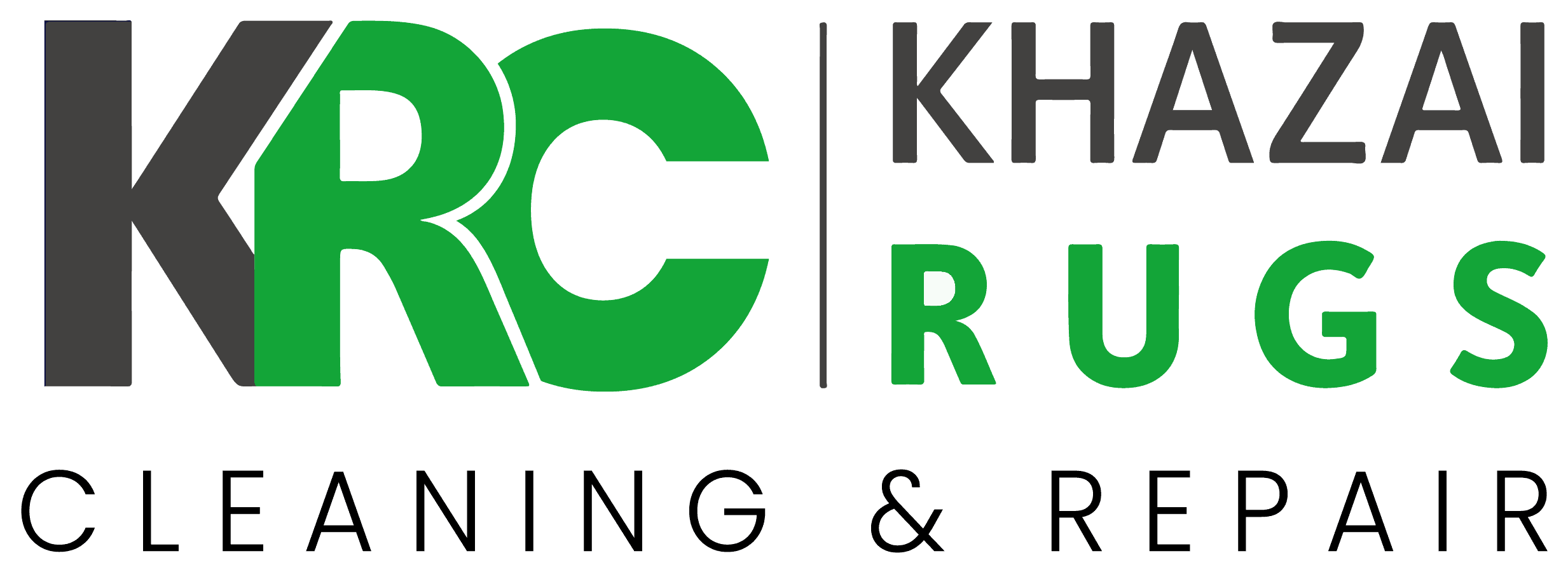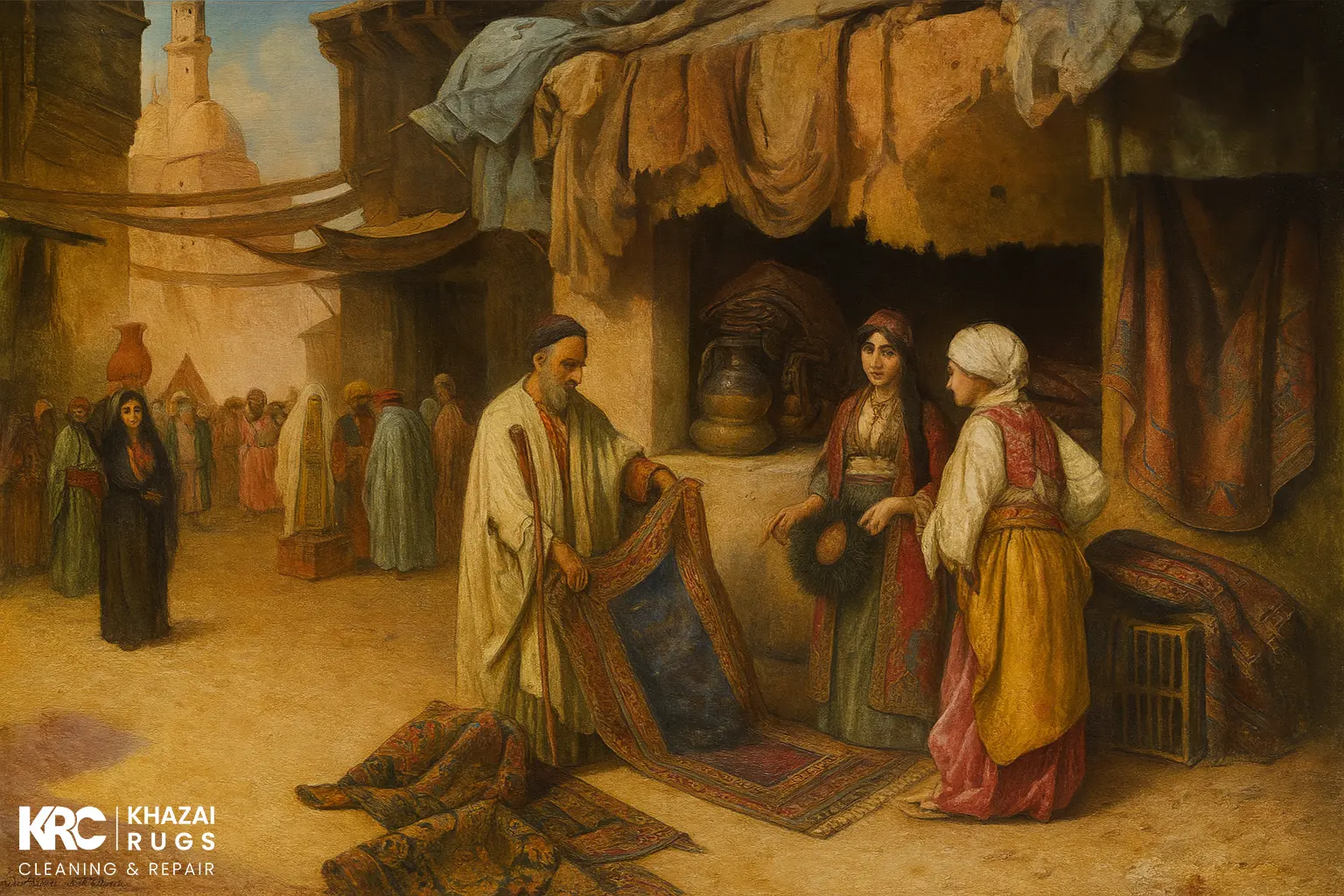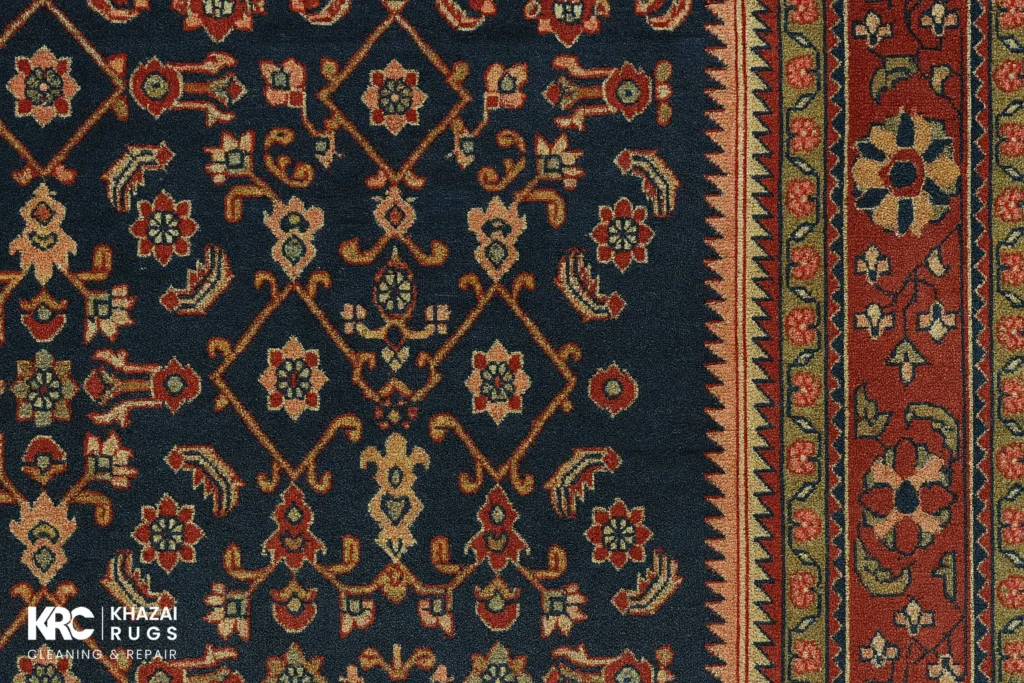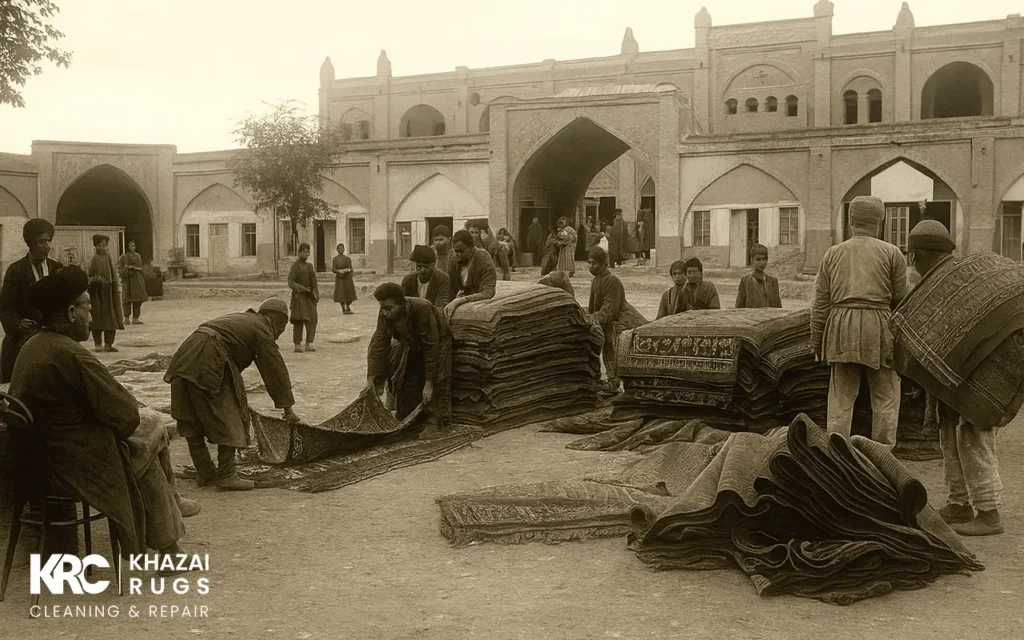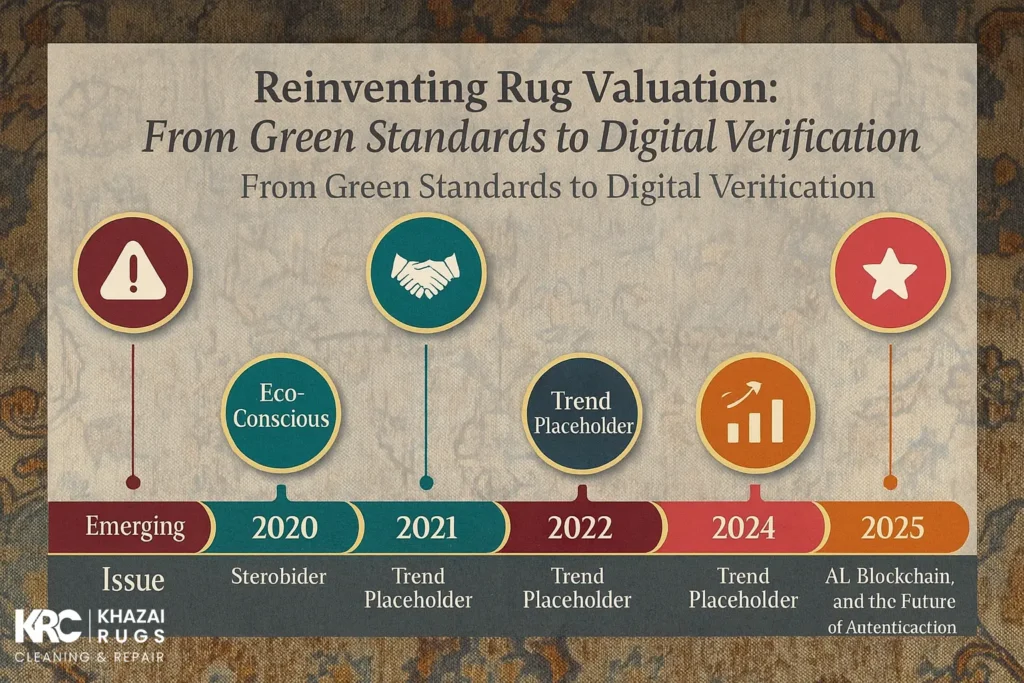The rug appraisal timeline is a story of eyes, hands, and market pulses learning to read a weave. We walk through early culture and barter, the jolt of factories, mid‑century booms, and the digital shift. Along the way, we connect regional styles, certified expertise, and new tech. As we share our take at Khazai Rug Cleaning, we’ll point out how care, storage, and smart appraisals support fair prices today. We trace the rug appraisal timeline through origins, industry, mid‑century shifts, the digital turn, regional styles, certified practice, eco trends, and tech, then end with what it all means for pricing today.
The Origins of the Rug Appraisal Timeline
Every rug value starts with context. This timeline begins with culture, ceremony, and trade routes. Inside these roots, historical rug valuation trends take shape long before written price lists. For early guidance or insurance needs, our Rug Appraisal Service explains what drives value and what to document.
Early Cultural Importance of Rugs
Woven pieces signaled rank, gift‑giving, and memory. A village prayer rug could carry names and seasons, not just motifs. Value leaned on maker, dye sources, and local demand. Stories moved with caravans, and so did prices. Our work still starts here—listening to the story before we measure the cloth.
Traditional Valuation Methods Across Civilizations
Markets in Persia, Anatolia, and the Caucasus compared pile height, knot count, and colorfastness by eye and touch. Barter set references. Over time, scribes noted provenance and repairs. These habits seeded the evolution of rug appraisal, giving later appraisers a baseline for method and fairness. Travelers compared knots and traded notes between markets.
How the Industrial Revolution Reshaped the Rug Appraisal Timeline
Factories sped up weaving and spread new dyes, and the valuation timeline bent under the weight of volume. Amid production gains, appraisal changes over time began to track machine output against village craft.
The Rise of Mass Production and Its Effects
Mass production lowered prices and flooded ports. Hand‑knotted pieces needed clearer separation from machine‑made. Appraisers leaned harder on materials, fringe construction, and design fidelity. Catalogs helped, but they could not replace the trained hand that knows how a wool thread should break. Prices drifted as imitations spread, so verification tightened.
Introduction of Standardized Pricing Models
Dealers pushed for a common language. Price sheets, auction notes, and shipping records nudged the craft toward consistency. Standardized models did not erase nuance; they organized it. From there, historical rug valuation trends became comparable across cities and seasons, chapter by chapter. That record-keeping highlights appraisal changes over time without erasing character.
Early Appraisal Practices in Western Markets
Western markets prized bold medallions and room sizes, then shifted taste as interiors changed. Early appraisers weighed dye stability and workshop reputation alongside wear. That mix shows early footprints in the evolution of rug appraisal that still guide today’s condition calls. Interior tastes tugged at metrics, yet structure still mattered.
The Mid-20th Century Shift in Rug Valuation
After the war, families wanted color and comfort. Across oceans, values shifted with imports, and appraisal changes over time reflected supply waves, tariffs, and new retail habits.
Post-War Demand and Import Booms
Ships arrived stacked with village and city pieces. Department stores featured them next to sofas and lamps. Appraisals grew to account for fast turnover and sales promos. Condition and authenticity still ruled, but availability and trend cycles nudged fair market ranges. Labels, tariffs, and shipping delays quietly shifted baseline expectations.
Antique Rug Appraisal Trends of the 1950s–1970s
From the 1950s through the 1970s, antiques gained a steady fan base. Scholars mapped patterns to towns; dealers built reference libraries. These decades sharpened historical rug valuation trends and trained a generation able to spot a re‑dye from across a room. Their field notes fueled the evolution of rug appraisal.
The Digital Age and Its Influence on the Rug Appraisal Timeline
Then came pixels and databases. Our field entered the digital age, where images, comps, and provenance live side by side. The evolution of rug appraisal picked up speed as data became searchable.
Emergence of Online Rug Marketplaces
Online marketplaces widened the buyer pool and exposed prices to daylight. A single listing reaches continents. That reach adds reference points and noise. Sorting the signal requires training and restraint, which is why we vet comps before they inform a number. Photos improved, but lighting tricks kept seasoned eyes cautious.
How Digital Cataloging Changed Valuation Standards
Digital cataloging brought order. We log size, materials, weave, dyes, and condition notes. Better records mean repeatable calls. This discipline supports historical rug valuation trends while leaving room for judgment. Cleanliness matters, too, so our Rug Cleaning Service supports condition grades before final notes.
Virtual Appraisals and Remote Authentication
Remote reviews grew from convenience into a real option. Clear photos, macro shots, and fiber details help. We still request provenance. For complex cases, we recommend an in‑person follow‑up through our Rug Appraisal Service to keep the evolution of rug appraisal grounded in careful inspection.
Regional Factors That Impact the Rug Appraisal Timeline
Geography shapes price. This work reflects regional schools, materials, and trade routes, and historical rug valuation trends make more sense once the place is understood.
Persian, Turkish, and Caucasian Rugs in Historical Context
Persian court pieces, Turkish village weaves, and Caucasian geometrics each bring distinct signals. Wool character, color palettes, and motifs guide attribution. We pair book knowledge with hand memory, treating each origin with the care it deserves. City looms favored precision; village looms prized rhythm and wool character. Design tells region.
Shifting Global Demand and Supply Patterns
Demand shifts with interiors and collecting waves. Supply changes with politics, climate, and workshop health. Those currents explain appraisal changes over time across regions, as certain types rise or cool without changing their core quality. Currency swings tilt bids. Shipping costs matter.
The Role of Certified Appraisers in the Modern Rug Appraisal Timeline
People set numbers, not machines alone. Progress depends on training, standards, and ethics, and the evolution of rug appraisal is visible in the tools we use.
Training, Accreditation, and Ethical Standards
Education matters. We study materials, dyes, regional histories, and behavior. Accreditation keeps practice aligned and transparent. Ethics keep the client first and the report clear. Practice never stops. We review case studies, mentor new appraisers, and log results so judgment grows instead of getting stuck.
How Certification Improves Valuation Accuracy
Credentials and process reduce bias and anchor comps. With a structured approach, valuation ranges narrow toward reality. That steadiness protects buyers, sellers, and insurers in plain, readable language. Peer review and defensible notes matter. Reports read cleanly, clients understand ranges, and insurers can file claims without translation. It keeps outcomes consistent.
Appraiser Tools Then vs Now
Yesterday’s loupe and ledger now sit beside calibrated lighting and microscopy. We still rely on the trained hand. New tools sharpen it, not replace it. Simple aids like our Rug Padding Service reduce wear that skews condition calls and reflect the evolution of rug appraisal.
Recent Trends Reshaping the Rug Appraisal Timeline
New pressures shape numbers today. The path now includes sustainability goals, material awareness, and rising tech that tracks authenticity at the thread level.
Eco-Conscious Collectors and Sustainable Appraisal Criteria
More clients want repair histories, safe cleaning, and proof of responsible sourcing. We reflect those values in condition notes. This lens interacts with historical rug valuation trends. Fiber‑safe care through our Rug Pet Stain Removal Service preserves dye integrity and prevents discounting. Buyers ask for proof.
What the Rug Appraisal Timeline Reveals About Market Value Today
So what does this timeline tell us right now? It shows a market that rewards clarity, documented care, and honest restoration, while discounting shortcuts.
Historic Data vs Modern Market Behavior
Historic data gives a map. Modern behavior adds weather. Together, they guide price ranges. We read long arcs next to current comps. Proper storage through our Rug Storage Service keeps fibers stable. In reports, we note appraisal changes over time for clients.
Predicting Future Trends from Appraisal Patterns
Patterns point ahead. Strong provenance, careful repairs, and responsible cleaning tend to hold value. Regional rarities rise as information spreads. We watch those arcs and adjust reports so clients can plan with clarity. We favor steady signals over noise and write clear ranges so decisions feel calm and practical. That keeps choices steady. Sensitive restoration through our Rug Repair Service can stabilize value when performed with period‑correct methods.
Conclusion
The rug appraisal timeline keeps moving, but its heart stays the same. We match hand knowledge with clean records and fair comps, then speak plainly about risk and value. At Khazai rug cleaning, we care for the piece before and after the report, so the number lasts as long as the weave.

